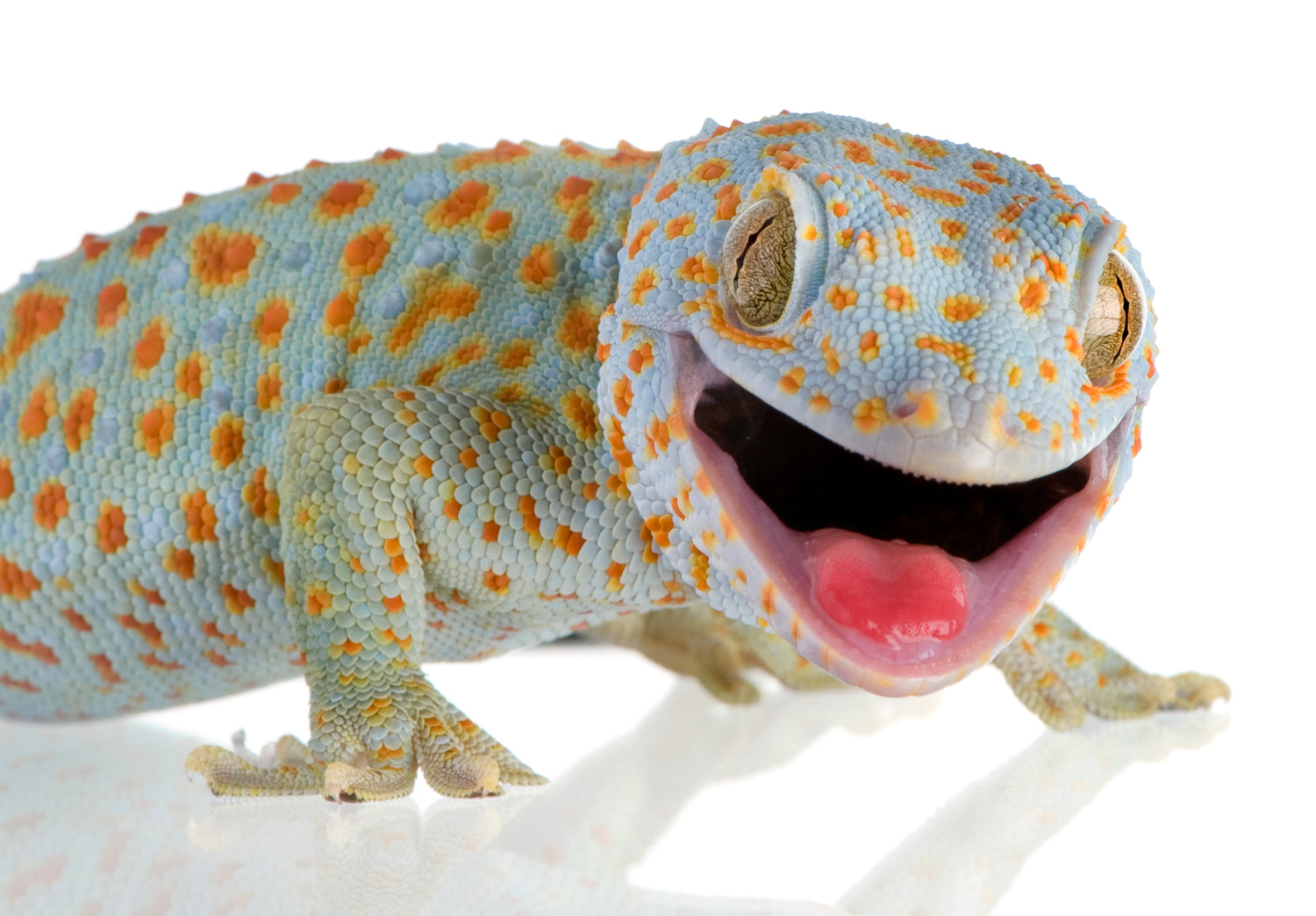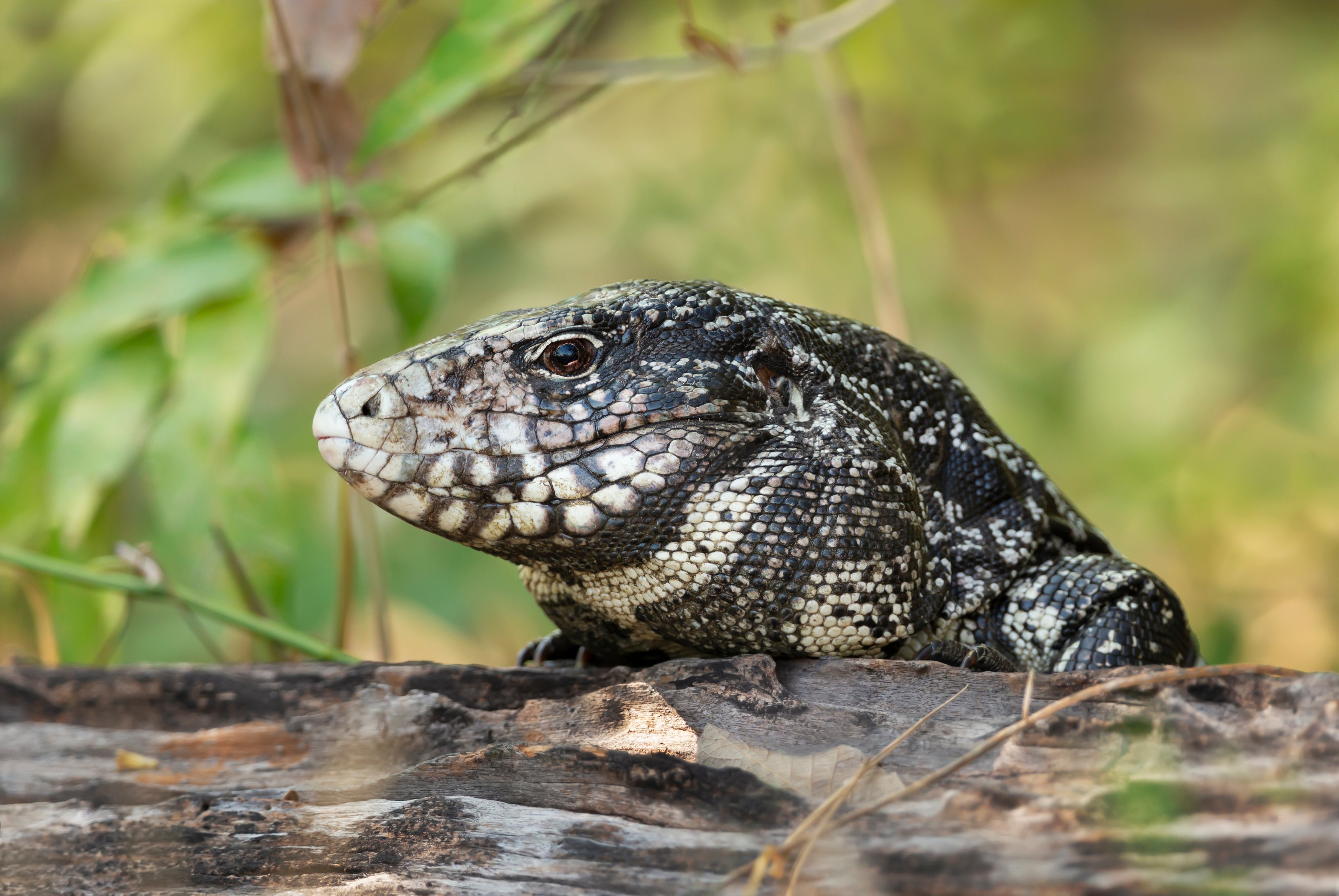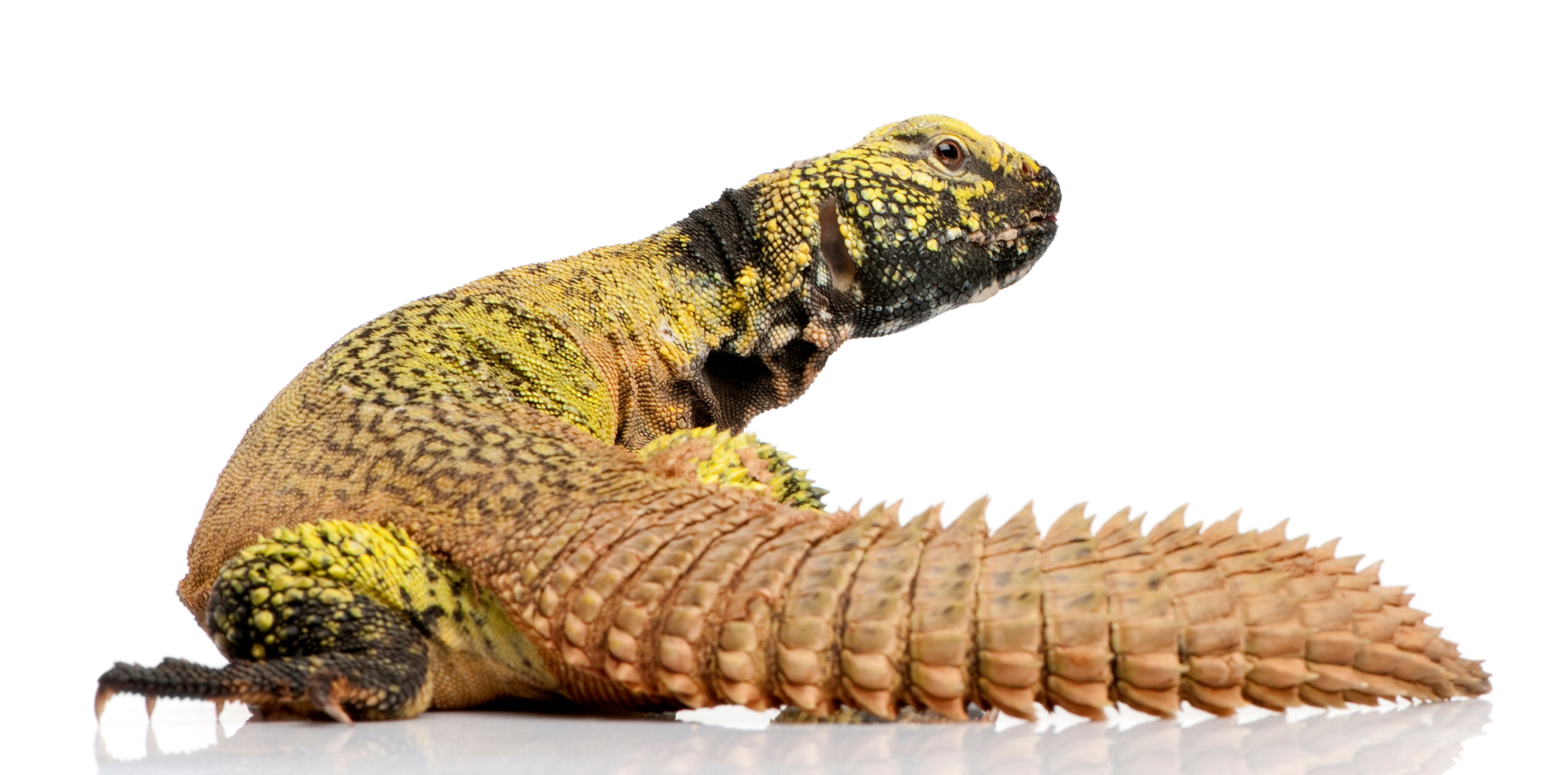Tokay geckos (Gekko gecko) are large, nocturnal, arboreal lizards native to Indonesia, parts of India, and the Philippines. They generally inhabit tropical rainforest, but have adapted well to rural human habitations.
Tokay geckos are generally 10-12” long, but larger is possible. They have large heads, large, prominent eyes, bumpy skin, a semi-prehensile tail, and sticky toe pads. This makes them proficient climbers. Wild-type tokay geckos are pale grayish-blue with orange or red spots. However, captive breeding has expanded the range of available colors and patterns.
Tokays are generally highly defensive and even aggressive toward humans, which makes them a poor pet for the impatient or faint of heart. But with patience and appreciation for their vivacity, they can make interesting pets. Tokay geckos generally live around 10 years in captivity.
Fun fact: Tokays are known for their vocalizations, which some cultures have transcribed to sound like “to-kay,” resulting in their common name!
How much space do tokay geckos need?
As large, active geckos, tokays need an enclosure that accommodates their needs. The absolute minimum enclosure size for appropriately housing a single Tokay gecko is 18”L x 18”W x 36”H. Of course, larger is always better!
Cohabitation (keeping multiple tokay geckos together) is not recommended, as this species is highly territorial. Fighting and injuries is likely to result if cohabitation is attempted.
Do tokay geckos need UVB?
Because tokay geckos are nocturnal, they can technically survive without UVB lighting as long as they get vitamin D3 from their food. However, installing appropriate UVB lighting as part of their setup is necessary for them to thrive in captivity, and is highly recommended.
The best UVB bulbs for tokay geckos housed in an 18” x 18” x 36” terrarium are:
The basking branch should be 8-10” below the UVB lamp for best results. The UVB bulb should be housed in a reflective fixture and placed close to the heat lamp. UVB is blocked by glass and plastic, so you can’t give your gecko UVB by placing its terrarium in front of an open window. Also make sure that the fixture your UVB bulb is in does not have a clear plastic bulb cover.
Lights should be on for 12 hours/day, and don’t forget to change your UVB bulb every 6-12 months according to manufacturer recommendation!
What basking temperatures do tokay geckos need?
Tokay geckos should have a basking temperature of 90-105°F, as measured by a digital probe thermometer with the probe placed on the basking branch. There should be a cooler area in the lower regions of the enclosure that stays between 80-85°F. Nighttime temps should be between 76-80°F.
Provide daytime heat for your gecko by imitating the sun with a halogen heat lamp on one side of the enclosure. Low-intensity nighttime heating should be provided with a lightless heat source like a deep heat projector (DHP) or ceramic heat emitter (CHE).
What humidity levels do tokay geckos need?
Tokay geckos need a high humidity environment for best health. Average humidity should be 70-80%, as measured by a digital probe hygrometer with the probe in the middle of the terrarium. Humidity will likely fluctuate higher at night and lower during the day, however it should not drop lower than 60%.
Misting your gecko’s enclosure with a sprayer first thing in the morning and again at night will help create the right humidity levels. It also provides an important source of drinking water!
If you have difficulty maintaining high humidity levels, running a reptile humidifier intermittently through the night can help.
What substrate is good for tokay geckos?
Although tokay geckos spend very little time on the ground, substrate helps maintain humidity and also contributes to the enclosure’s overall attractiveness. It’s ideal to use a substrate that imitates the “substrate” that the reptile naturally lives on in the wild. For tokays, that means it should resemble tropical soil.
We recommend the following substrates for tokay geckos:
Layering clean, chemical-free leaf litter on top of the substrate can also help with humidity.
Substrate should be at least 2” deep and completely replaced every 3-4 months. Remove poop and urates daily, along with contaminated substrate.
What décor can you use in a tokay gecko terrarium?
It’s terribly boring for a reptile to be stuck in an enclosure with nothing in it except dirt. It doesn’t matter how big the enclosure is if you don’t put things in it for your pet to use and interact with. Tokay geckos tend to appreciate a fairly densely planted enclosure with either live or artificial plants, which can make their terrarium a great piece of home décor!
Tokay geckos are strictly arboreal, so at bare minimum, you will need a couple of branches for your gecko to climb on and some live or artificial foliage for it to hide in. However, it’s best to include other items, such as:
Since tokay geckos are fairly large, make sure that any decor you use is sturdy enough to support the lizard’s weight — especially with live plants!
What do tokay geckos eat?
Tokay geckos are carnivorous, which means that they need to eat a variety of animal prey in order to get the nutrition that their bodies need. They mostly eat insects in captivity, but they are also known to take small vertebrates such as mice, frogs, small lizards, and even small snakes.
Juvenile tokay geckos should be fed daily, while adults only need to be fed every other day. Offer juveniles as much as they will eat. Adults should be offered as much as they will eat in about 5 minutes.
Feeder insects for tokay geckos: dubia roaches, discoid roaches, red runner roaches, crickets, black soldier flies, hornworms, silkworms, mealworm beetles, superworm beetles
Pinky/fuzzy mice can be offered 1-2x/month. Feeder anoles and house geckos can also be offered.
Supplements
You will also need calcium and vitamin supplements to help prevent your tokay gecko from developing a deficiency. We recommend Repashy Calcium Plus LoD, lightly dusted on all of your lizard’s feeder insects.
Water
Although your gecko will get most of its drinking water from daily mistings, it’s a good idea to also provide a wall-mounted water dish. Change the water daily and scrub the bowl with a reptile-safe disinfectant weekly, or whenever it becomes soiled.
Do tokay geckos like to be handled?
Few reptiles actually “like” to be held, and tokay geckos usually aren’t one of them. Most tokay geckos in the US pet trade are wild-caught, and they can be very bitey and defensive around humans. A bite from a tokay gecko is no small thing! That being said, it is not impossible to tame a tokay gecko — it just requires lots of patience to build up trust. Kevin McCurley of NERD explains the tokay taming process well here.
Generally speaking, though, tokay geckos are better display animals than a pet that you can hold regularly. Instead of interacting with your gecko by holding it, try hand-feeding it with a pair of feeding tweezers.
*This care sheet contains only very basic information. Although it’s a good introduction, please do further research with high-quality sources to obtain additional information on caring for this species.




Leave a comment
This site is protected by hCaptcha and the hCaptcha Privacy Policy and Terms of Service apply.